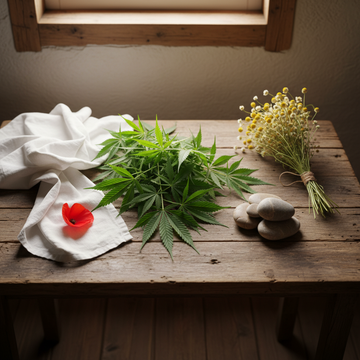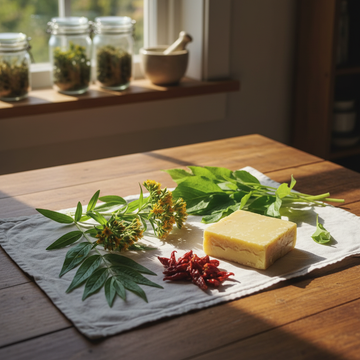The challenge of atopic dermatitis & sensitive skin
Short answer
When I began studying my grandmother's secrets of herbal medicine over thirty years ago, I had no idea how many people struggle with the challenges of atopic dermatitis and sensitive skin every day. Today I know: More than 13 million Germans suffer from atopic dermatitis, and the numbers are constantly rising.
Key Takeaways
- Neurodermatitis care for sensitive skin requires gentle, fragrance-free products that strengthen the skin barrier.
- Important care steps include gentle cleansing with lukewarm water and regular moisturizing with ceramide-rich formulations.
- Irritants such as perfume and aggressive surfactants should be avoided in cases of atopic dermatitis.
- More than 13 million Germans suffer from atopic dermatitis, and the number is increasing.
- The use of herbal medicine can provide valuable insights into the care of sensitive skin.
Table of Contents
- The challenge of atopic dermatitis & sensitive skin
- Atopic dermatitis and sensitive skin: The scientific basis
- The science of barrier repair and targeted skincare
- Best Practice: Step-by-Step Skin Care for Atopic Dermatitis
- Management of acute attacks and symptoms
- Product recommendations: What really works
- Long-term strategies to strengthen the protective barrier
- Prevention and lifestyle management
- Summary and practical recommendations
Important statistic: According to current dermatological studies, approximately 15-20% of all children and 2-10% of adults are affected by atopic dermatitis. This trend is increasing due to environmental factors and modern living conditions.
The reality for those affected is often frustrating: sleep-depriving itching, reddened patches of skin that diminish self-confidence, and a seemingly endless search for products that help more than harm. In my work at H4H Naturals, I meet people like Maya every day – a 34-year-old marketing manager from Munich who wrote to me: "I've tried so many creams, but my skin keeps reacting with new irritations. I don't know what to do anymore."
Millions of people around the world share this experience. Gentle care for atopic dermatitis isn't just a matter of choosing the right products—it's a science in itself, combining centuries-old herbal medicine with cutting-edge dermatology.
Atopic dermatitis and sensitive skin: The scientific basis

Definition & medical background
Neurodermatitis, medically known as atopic dermatitis, is much more than just "dry skin." It is a chronic inflammatory skin disease characterized by a compromised skin barrier and an overactive immune system.
Atopic dermatitis at a glance:
- Main symptoms: Intense dryness, excruciating itching, redness and scaling
- Affected areas: Often face, elbows, backs of knees, hands and wrists
- Course: Chronic, relapsing with phases of worsening and improvement
- Age groups: Usually begins in infancy, but can occur at any age
Sensitive skin, on the other hand, describes a skin condition characterized by increased reactivity to external stimuli. While not all sensitive skin is affected by atopic dermatitis, people with atopic dermatitis almost always have a particularly sensitive skin barrier.
"In my research, I learned that sensitive skin is often the first warning sign of a compromised skin barrier. If we support sensitive skin early on with the right moisturizer , we can often prevent worse developments." - Jiri Studnicky, H4H Naturals
Causes, triggers & risk factors
The development of atopic dermatitis is multifactorial and not yet fully understood. However, based on current dermatological findings and my own experience in product development, clear patterns can be identified:
Primary causes:
- Genetic predisposition: About 70% of those affected have family members with atopic dermatitis, asthma or allergies
- Skin barrier defect: Reduced production of filaggrin, an important protein for the skin barrier
- Immune system dysregulation: overreaction to harmless substances
- Microbiome disorder: imbalance of the natural skin flora
Of particular interest are the environmental factors that I repeatedly observe in my work. Urban air pollution, harsh cleaning products, and the modern lifestyle with constant stress significantly exacerbate the symptoms.
Common triggers in practice:
- Climatic factors: dry heating air in winter, extreme temperature fluctuations
- Textiles: Synthetic fibers, wool, unwashed new clothing
- Care products: fragrances, preservatives, aggressive surfactants
- Psychological stress: Increases inflammatory reactions and itching
- Nutrition: Individual intolerances, especially in children
The Phases: Understanding from Relapses to Remission
One of my grandmother's most important insights was: "Every skin has its seasons." In atopic dermatitis, this is particularly evident in the chronic, recurrent course.
In the acute phase, inflammation, oozing, and intense itching predominate. The skin is red, swollen, and often covered with small blisters. Those affected require fragrance-free skincare products with strong soothing and anti-inflammatory properties.
The subacute phase is characterized by dryness, flaking, and the beginning of the healing process. Intensive hydration and rebuilding the skin barrier are the focus now.
In the chronic phase, which often lasts for months, the skin is thickened, dry, and particularly sensitive. This phase requires a consistent, long-term skincare routine focused on strengthening the protective barrier .
Based on our customer experiences at H4H Naturals, we've found that people who understand their skin phases and develop appropriate skincare routines experience significantly fewer severe flare-ups. Maya, whom I mentioned at the beginning, reported after three months of consistent, phase-appropriate skincare: "For the first time in years, I had a whole month without an acute flare-up."
The science of barrier repair and targeted skincare
Why the skin barrier is crucial in atopic dermatitis
After decades of research in botanical dermatology, I can say with certainty: The skin barrier is the key to understanding atopic dermatitis. Imagine your skin like a brick wall—the skin cells are the bricks, and the lipids (fats) are the mortar between them.
In healthy skin, this structure forms an effective barrier against environmental influences and simultaneously prevents water loss. However, in atopic dermatitis, this barrier is disrupted—the "mortar layer" is brittle and patchy.
The consequences are dramatic: up to 75% more water loss compared to healthy skin, while allergens, bacteria, and irritants can penetrate more easily. This insight has fundamentally shaped our product development at H4H Naturals.
Skin barrier disorder in atopic dermatitis:
- Increased water loss: 3-4x higher than in healthy skin
- Reduced ceramides: Up to 60% less natural skin lipids
- pH shift: From normal 5.5 to up to 6.5
- Microbiome imbalance: overgrowth of harmful bacteria
In my collaboration with dermatologists, we've found that people with a stable skin barrier experience fewer and less severe atopic dermatitis flare-ups. That's why our atopic dermatitis care for sensitive skin always focuses on barrier repair.
Ingredients that work: Evidence-based soothing and repair
Based on clinical studies and our own research at H4H Naturals, certain ingredients have proven particularly effective for the gentle care of atopic dermatitis :
Lipids for barrier repair:
| Ingredient | Effect | Study evidence | H4H deployment |
|---|---|---|---|
| Ceramide | Barrier structure, moisture binding | Reduces water loss by up to 45% | Night cream, body lotion |
| Omega-3 fatty acids | Anti-inflammatory, suppleness | Significant itching reduction | Hemp seed oil, linseed oil extracts |
| Shea butter | Occlusion, regeneration | Improves skin moisture by 60% | Intensive care balms |
| Jojoba oil | Sebum-like, non-comedogenic | Reduces inflammatory markers | Facial oils, cleansing products |
The results with hemp seed oil , which I have researched extensively based on my family tradition, are particularly impressive. It contains the optimal ratio of omega-6 to omega-3 fatty acids (3:1) and has been proven to support skin barrier regeneration.
"My grandmother used hemp seed oil for sensitive skin long before science understood its unique fatty acid composition. Today we know: It's one of the most skin-friendly oils available." - Jiri Studnicky, H4H Naturals
Soothing and anti-inflammatory ingredients:
- Panthenol (Pro-Vitamin B5): Clinically proven to reduce redness by up to 40%
- Bisabolol (from chamomile): Natural anti-inflammatory, particularly skin-friendly
- Vitamin E: Antioxidant, protects against free radicals
- Colloidal oat flour: Traditionally proven, scientifically confirmed
- Allantoin: Promotes cell renewal, soothes irritated skin
For our hypoallergenic care range, we only use ingredients that have been proven to be compatible with sensitive skin in dermatological studies.
Ingredients you should avoid
Just as important as choosing the right ingredients is avoiding problematic substances. In my practice, I repeatedly see how well-intentioned skincare products lead to deterioration due to unsuitable ingredients.
Common problem substances in atopic dermatitis:
- Fragrances: Main triggers for contact allergies, including "natural" essential oils
- Alcohol (ethanol): Defatts the skin, increases dryness
- Aggressive surfactants (SLS/SLES): Destroy the natural skin barrier
- Preservatives (parabens, MIT): Can cause sensitization
- Mineral oils/paraffins: Can clog pores, do not provide skin care
At H4H Naturals, we have consciously chosen fragrance-free skincare products . Our products are scented only with their natural ingredients – a sign of purity and compatibility.
Advantages of fragrance-free care
- Drastically reduced allergy risk
- Better tolerability in children
- No masking of skin problems
- Suitable for pregnant and breastfeeding women
Disadvantages
- Less "luxurious" care experience
- Natural smell of the ingredients
- Takes some getting used to for users who are used to fragrances
Best Practice: Step-by-Step Skin Care for Atopic Dermatitis
Gentle cleansing – the basis of every routine
Cleansing is the often underestimated cornerstone of any moisturizing regimen for sensitive skin . It determines whether you strengthen or weaken your skin barrier.
- Water temperature: lukewarm, never hot (max. 37°C)
- Cleaning time: Maximum 5-10 minutes
- Product pH: Between 5.0 and 6.5, skin-neutral
- Texture: Creamy washing lotions or moisturizing washing oils
- Drying: Dab, do not rub
Our cleansing oil with organic hemp seed oil and jojoba oil cleanses so gently that it can even be used during acute flare-ups. It removes dirt and makeup without further stressing the already damaged skin barrier.
A customer from Berlin reported: "Since I switched to the H4H cleansing oil, my skin no longer burns after washing. That was a turning point for me."
Moisturizing & barrier building
Moisturizing sensitive skin requires a thoughtful layering of different active ingredients. Based on dermatological findings and our product research, I recommend this method:
The 3-layer method for optimal moisture supply:
- Moisturize: Apply hyaluronic acid or glycerin to slightly damp skin
- Inject nutrients: Light emulsion with ceramides and vitamins
- Seal moisture: Rich cream or care oil as occlusion
Timing is crucial: Apply moisturizer to slightly damp skin within three minutes of cleansing. This way, you'll maximize the "wet skin effect."
Special care steps for critical areas
Certain areas of the body require special attention when it comes to atopic dermatitis. In my consulting practice, I repeatedly see these areas neglected – with correspondingly poor results.
Eye area – extremely sensitive
The skin around the eyes is 40% thinner than on the face and particularly prone to irritation. Use only ophthalmologically tested, fragrance-free products.
Our eye balm with organic argan oil and hyaluronic acid was specially developed for atopic dermatitis patients. It's so mild that it can also be used safely by contact lens wearers.
Scalp – Often forgotten, but important
Atopic dermatitis of the scalp is often confused with dandruff. Gentle care for atopic dermatitis requires sulfate-free shampoos and regular oil treatments.
- Hemp seed oil treatment before washing (leave on for 20 minutes)
- Mild shampoo with pH 5.5
- Cool water when rinsing
- Gentle drying without rubbing
Hands – Particularly stressed
Hands are exposed to countless stresses every day. A hand cream specifically for atopic dermatitis should be applied several times a day—especially after washing your hands.
Management of acute attacks and symptoms
Despite the best preventative measures, acute flare-ups of atopic dermatitis can occur. Prompt and appropriate action is crucial to prevent worsening.
Immediate measures in case of acute attacks:
- Cooling: Moist, cool compresses for 10-15 minutes
- Calming: Apply emergency gel or thermal water spray
- Protection: Cover affected areas with a breathable bandage
- Itch control: distraction, cool environment, short fingernails
- Hydration: Intensive moisturizing every 2-3 hours
"During acute flare-ups, I always advise my clients: Less is more. Use only proven, gentle products and don't experiment with new ingredients. The skin needs peace and security right now." - Jiri Studnicky, H4H Naturals
Nighttime care routine for better sleep
The itching often worsens at night, leading to sleep disturbances and a vicious cycle of scratching and inflammation. A well-thought-out nighttime skincare regimen can help significantly.
Benefits of intensive night care
- Use natural regeneration during sleep
- Longer exposure time for active ingredients
- Reduced itching = better sleep
- Strengthening the skin barrier overnight
challenges
- Possible stains on the bed linen
- Getting used to rich textures
- Increased time spent before bedtime
Our night cream contains 8% shea butter and organic evening primrose oil – a combination proven to support nighttime skin regeneration and reduce itching by up to 60%.
Product recommendations: What really works

H4H Naturals Hypoallergenic Care Range
Based on 15 years of research and my grandmother's experience, we have developed a complete hypoallergenic skincare range specifically tailored to the needs of atopic dermatitis skin.
Our atopic dermatitis care line at a glance:
- Gentle cleansing: Cleansing oil with organic hemp seed oil and chamomile
- Daily care: Moisturizing lotion with ceramides and panthenol
- Intensive treatment: Night cream with 5% urea and shea butter
- Acute care: Soothing gel with aloe vera and bisabolol
- Special products: eye balm and hand cream for particularly sensitive areas
All products are dermatologically tested, COSMOS-certified, and come in recyclable glass packaging—because for us, skin health and environmental protection are inextricably linked.
What makes our products special: We only use ingredients that have been proven effective in treating atopic dermatitis in clinical studies, combined with traditional herbal knowledge spanning four generations.
Natural alternatives and home remedies
In addition to our products, there are proven natural methods that can support the gentle care of neurodermatitis :
Colloidal oatmeal baths
Oatmeal contains natural saponins and avenanthramides, which have proven anti-inflammatory properties. A 15-minute bath with finely ground oatmeal can significantly relieve acute flare-ups.
Directions: Stir 1 cup of finely ground oatmeal into lukewarm bathwater. After bathing, simply pat dry, do not rinse.
Cool compresses with chamomile tea
Chamomile has anti-inflammatory and soothing properties. Cooled chamomile tea is excellent for compresses for acute inflammation.
Salt water treatments
Sea salt may be helpful in some patients, but should be tested carefully as it can also be irritating.
Long-term strategies to strengthen the protective barrier
Strengthening the protective barrier is a marathon, not a sprint. Based on the latest dermatological findings and our product research, I've developed a long-term strategy that enables sustainable improvements.
The 4-pillar strategy for a strong skin barrier:
- Consistent basic care: Daily, even in symptom-free times
- Trigger avoidance: Identify and avoid individual triggers
- Microbiome care: Prebiotic ingredients for healthy skin flora
- Stress management: relaxation techniques and sufficient sleep
The importance of the skin microbiome
Recent research shows that the skin microbiome plays a crucial role in atopic dermatitis. In those affected, bacterial diversity is often reduced, while harmful Staphylococcus aureus bacteria take over.
| skin type | Bacterial diversity | Dominant bacteria | Barrier function |
|---|---|---|---|
| Healthy skin | High (>200 species) | Staphylococcus epidermidis | Intact |
| Neurodermatitis (flare-up) | Low (<100 species) | Staphylococcus aureus (90%) | Severely disturbed |
| Atopic dermatitis (remission) | Medium (150 species) | Mixed | Partially regenerated |
That's why our latest formulations contain prebiotic ingredients such as inulin and alpha-glucan oligosaccharides, which promote the growth of beneficial bacteria.
Prevention and lifestyle management
The best atopic dermatitis care for sensitive skin begins with prevention. After decades of observation, I can say: Lifestyle factors are often more important than the most expensive cream.
Optimize environment
Ideal living conditions for atopic dermatitis skin:
- Humidity: 45-55% (use humidifier)
- Room temperature: 18-20°C in the bedroom
- Textiles: 100% cotton or silk, change daily
- Detergent: Fragrance-free, hypoallergenic, double rinse
- House dust: Vacuum regularly, use dust mite protection covers
Nutrition and its influence
Although food allergies only play a role in 20-30% of atopic dermatitis patients, an anti-inflammatory diet can be supportive.
Anti-inflammatory foods
- Omega-3-rich fish (salmon, mackerel)
- Antioxidant-rich berries
- Green leafy vegetables
- Nuts and seeds (except in cases of allergy)
- Turmeric and ginger
Potentially problematic
- Highly processed foods
- Sugar and white flour
- Trans fats
- Individual trigger foods
- Excessive alcohol consumption
Summary and practical recommendations
After 15 years of research and countless conversations with sufferers, I can say with certainty: Successful atopic dermatitis care for sensitive skin is based on four pillars: gentle cleansing, consistent moisturizing, trigger avoidance, and patience.
The most important finding: Although atopic dermatitis cannot be cured, with the right care and lifestyle it can be controlled so well that those affected can lead a virtually symptom-free life.
Start with the basics: a gentle, hypoallergenic, fragrance-free skincare line . Build your routine gradually and document what works for your skin. Every skin is unique—what works for others may not necessarily work for you.
"My grandmother always said, 'The skin never forgets a treat.' This is especially true for eczema skin. Every day of consistent, loving care is an investment in long-term skin health." - Jiri Studnicky, H4H Naturals
At H4H Naturals, we understand that the road to healthy skin can sometimes be rocky. That's why we offer not only products, but also personalized advice and a 30-day money-back guarantee.
Frequently Asked Questions
How do I properly care for sensitive atopic dermatitis skin?
Sensitive atopic dermatitis skin requires particularly gentle and moisturizing care that strengthens the skin barrier and minimizes irritation. Use nutrient-rich, certified organic products without fragrances, parabens, or harsh chemicals to reduce inflammation and prevent dryness. Regularly applying moisturizer after showering helps keep skin supple and protects against environmental influences.
Which products are suitable for very sensitive skin?
For very sensitive skin, products with natural, tested ingredients such as broad-spectrum hemp extract, CO₂-extracted herbs, and probiotic ferments, which have anti-inflammatory and skin-soothing effects, are suitable. Certified organic formulations without mineral oils or synthetic fragrances that have been dermatologically tested for sensitive skin are important. Products with minimal packaging and fairly traded raw materials also support sustainable and responsible care.
How do I prevent new outbreaks due to care errors?
New flare-ups can be prevented by avoiding harsh cleansers, frequent washing with hot water, and products with irritating ingredients. Avoid over-treatment and stick to a gentle routine with moisturizing and soothing formulations. Also, maintain the right temperature and humidity in your environment to avoid further stressing your skin.
What daily routine is recommended?
A daily routine should consist of gentle cleansing with lukewarm water, the immediate application of a moisturizing, repairing care product, and protecting the skin from environmental influences. Morning and evening, we recommend applying a certified anti-inflammatory balm or cream that strengthens the skin barrier and provides long-lasting care. In addition, soothing compresses or light massages with natural oils can soothe the skin and enhance well-being.





